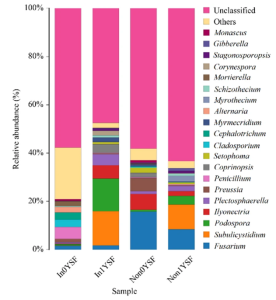A group from Engineering Research Center of Agricultural Microbiology Technology, Ministry of Education, Heilongjiang University, Harbin, China, etc. has reported about effects of inoculation of AM fungi (Rhizophagus intraradices) on soybean yield and the composition of microbial communities.
https://www.nature.com/articles/s41598-022-22473-w
The field experiment was done in triplicate with AM fungal treatments (non-inoculated and inoculated with Rhizophagus intraradices) and continuous cropping regimes (0 and 1 year of continuous cropping for soybean) as factors, i.e., there were four conditions, In0, In1, Non0, and Non1.
The effect of AM fungal inoculation was seen greatly in the composition of fungal communities rather than the composition of bacterial communities. As shown below, the most dominant genus was Subulicystidium in In1YSF and Non1YSF. However, Fusarium was the most dominant genus in In0YSF and Non0YSF. Interestingly, the relative abundance of Fusarium decreased significantly from 15.72% in Non0YSF to 1.58% in In0YSF.
In response to this, the disease index of soybean root rot was significantly decreased by the inoculation of AM fungi. For example, the disease index with the AM fungal inoculation decreased to 66%. The growth/yield indexes of soybean increased by the AM fungal inoculation, and it was the highest in the inoculated soybean plants under non-continuous cropping.

